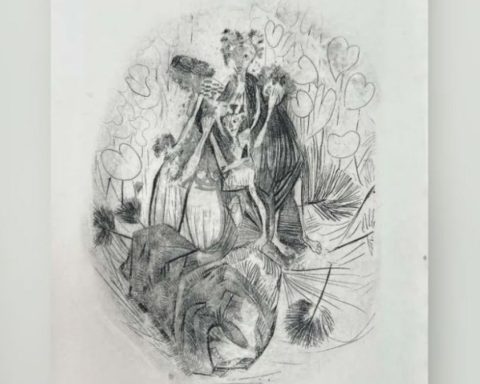“Why have the measures relative to consolidating their union been hidden from the Provinces under the new system? Why should they be kept ignorant of the prosperous or adverse news that manifests the successive state of the Peninsula? The questions correspond to the note that under the heading “Order of the Board” opens number 1 of the Gazette of Buenos Aires, which on June 7, 1810 became the first press organ of the fledgling Homeland.
Ask, interpellate, call for action. A gesture of modern and revolutionary journalism in Hispanic America subjected to the censorship and absolutism of the Spanish Crown. And on the cover of that first issue, just after the date, a phrase from the Roman historian Cornelius Tacitus so that there would be no doubt: “…with the rare happiness of times when thinking what you want and saying what you think is permitted”.
In memory of the appearance of the first number of the Gazette of Buenos Aires, in Argentina the day of the journalist is celebrated every June 7. This was established by the First National Congress of Journalists, held in the province of Córdoba in 1938.
The Gazette of Buenos Aires was promoted by Mariano Moreno and founded by order of the First Board five days before its appearance: on June 2, 1810. In the decree that created it, the first national government based its reason for being on “the right of the people to know the conduct of their representatives.” And it would stay alive for eleven years, when on September 12, 1821 Bernardino Rivadavia would replace it with the Official Registry.
spread the ideas

The writing of the publication was entrusted to the member and priest Manuel Alberti, although most of the texts were written by Moreno, the main ideologue of the May Revolution. At least, until his resignation from the Board in December 1810. Juan José Castelli, Manuel Belgrano, Pedro Agrelo and Bernardo de Monteagudo, among others, also participated in the brand new media.
“When the Board was established, the simple means of spreading ideas and making men communicative, which is carried out everywhere by this type of writing, was missed. This lack could not escape the penetration of Dr. Moreno, and his longing for the public good determined him to found an entirely new gazette, and that would never have been seen in the colonies under other circumstances”, he relates. Manuel Moreno, brother of the Secretary of the Board, in “Life and Memories of Mariano Moreno.”
La Gaceta was the fifth printed medium in Buenos Aires and the first of an autonomous government of the metropolis. Its immediate antecedents, the “Commercial Telegraph”, the “Semanario de Agricultura, Industria y Comercio” or the “Comercio de Buenos Aires”, lacked the context that was now presented: promote a government in the name of Ferdinand VII (captive of Napoleon) but with the ideology of Napoleon, or at least of the French Revolution: Liberty, Equality, Fraternity.
“The Gazeta de Buenos Ayres -adds Manuel Moreno- periodically came out twice a week, outside of the occasions that required an extraordinary publication, which occurred frequently” and sought to “excite the spirit of the people to examine their interests and their rights; establish the sound principles of their happiness, and combat the agents of tyranny.”
All for a peso
In its first issue, the Buenos Aires Gazette announces that its frequency will be weekly (every Thursday), its length will be one and a half sheets, and that it will be sold by subscription: one peso per month in Buenos Aires; ten reais “in the towns covered by the main Post Office”; and twelve reais in Chile and Peru.
The subscription had to be made at the Imprenta de Ninos Expósitos (where the newspaper was printed) and for a minimum period of three months for Buenos Aires and six for the rest of the destinations. In all cases the payment was in advance.
Number one
The article that opens the first issue of the Gazette is quite an editorial, both in the journalistic and political sense of the text. There, the guidelines outlined by Manuel Moreno in the text about his brother are established. Also the journalistic objectives: to reach the inhabitants of Buenos Airesreport on the measures of the provisional government (the Board should be expanded or replaced by a body that includes representatives of the so-called interior provinces) and give an account of the war against the French in Spanish territory.
“An exact notice of the procedures of the Board, a continuous public communication of the measures agreed upon to consolidate the great work that has begun, a sincere and frank manifestation of the obstacles that oppose the end of its installation and of the means that he adopts to smooth them out, they are a duty in the provisional government”, details the opening note, which has a distinctive design detail in its first capital letter.
And furthermore: “When the General Congress needs knowledge of the government plan that the Provisional Board has kept, its members will not shy away from giving it, and their frankness will banish all suspicion that they are necessary or fear being known, but it is more worthy of their representation trust public opinion to defend their procedures and that when everyone is going to have a part in deciding their fate, no one ignores those political principles that should regulate their resolution”.
Freedom of expression and the democratization of the debate on government policies appear as the axes of the text signed by Mariano Moreno as Secretary of the First Board. On the end it is also reported that Manuel Alberti will act as director of the brand new newspaper, receiving the writings to be published. All as a “sincere demonstration of appreciation” of the government towards “the people” for the trust placed in it to “ensure the happiness of these Provinces”.
News from here and there

Barely separated by a watermark (a kind of double mustache mustache), the publication continues with a series of news referring to the war in Spain: the interception and diversion of a frigate that had left Lima by the British Navy so that it does not fall into the hands of the French; and letters from Cádiz that give an account of the preparations in the port of that city of the Crown to repel the Napoleonic troops.
Then the local information returns. in them The resignation of the Porter of the Secretary of the Superior Government, who had served the deposed Viceroy Cisneros, stands out. And immediately a denial: that they have stopped paying the salaries to the “civilian employees” of the administration. What it is about, informs the text, is a new modality that establishes the need for a special decree of the Board. The objective: to order the disbursements and avoid discretionalities.
The inaugural edition of the Gazette continues with a slightly longer note than the previous ones, where the title “Order of the Board” is repeated (in italics as design detail). It refers to setting new tariffs for leather exports, establishing as a limit to this measure of economic policy “the celebration of the Congress of the dependent provinces”. A complete political declaration of integration between Buenos Aires and the so-called interior provinces, where the events of May were viewed with some suspicion.
The text that follows can be read in the same sense, referring to the oath and fidelity of all public officials to the new authorities. That is, to the First Board that emerged on May 25, 1810. It is the most political text, along with the opening editorial, of the first issue.
A chronicle full of adjectives (“magnificent show”, “happy result of such a respectable Assembly”, “sensitive souls fainted before the novelty of a very sweet impression”, etc.) that sought to reinforce the convenient loyalty to Fernando VII and suture the wounds open with the revolt that had deposed the Viceroy only a few days before.
“Everyone swore; and all will die, before they break the sacred obligation that they have imposed on themselves”, informs (and warns?) the note in its final paragraphs. And immediately he gives an account of the celebration, on May 30, of the Te Deum in the Cathedral, where there was a double celebration: the day of “our august monarch Don Fernando VII” and “the installation of the Board”. The text also records the participation of all “corporations, bosses and neighborhood.” And also of the “Excellent Mr. Don Baltazar Hidalgo de Cisneros”.
goalkeeper wanted
The most curious news in the inaugural edition of the Gaceta de Buenos Aires is the resignation of Don Blas Camble as Doorman of the Secretary of the Superior Government. It seems that Don Blas preferred to go with his employer, Baltazar Cisneros. The note states that despite the fact that the Board “begged him to continue” out of “consideration for the family” of the former Viceroy, Camble chose to “continue as a domestic of said Lord.”
In the midst of so much consideration for Cisneros and his family, patriots make a difference. They announce that they open the application to cover the position for eight days, “In understanding that this, like the other jobs subject to the provision of the Board” will be “award to the one who accredits the greatest merit”.
There is more information for this newsletter
In the final section, the publication returns to the news from “abroad”, as if it were taking up an imaginary “International” section: from United States they report on the presence of “many emissaries of José Bonaparte” in Baltimore, whose mission would be “to form parties”; an alert about the advance of Portuguese troops on national territory crossing “the southern band of Ibicuy”, about which the Board will take measures to “protect the integrity of the King’s territories”; and the letter “from a respectable person” reporting new news about the resistance in Spain to the French.
The last featured article in the first issue will be the partial publication of a proclamation from the Regency Council (highest authority for occupied Spain) summoning the “Spanish Americans” to send deputies to a national Congress to coordinate the fight against Napoleon, unify all the territories of the Spanish Crown and contribute to the “restoration and recomposition of the Monarchy.”
Although the text is not accompanied by comments of any kind, the printing and complete dissemination of the proclamation is promised. An informative act that for the most radical sector of the patriots, expressed in Moreno, Castelli and Belgrano, realized the complexity of the times to come. That is: the decline of the democratizing role played by the Boards in much of the Crown and the advance, restorative bias included, of absolutism that would evidence the Regency Council.
a cry of freedom
Already at the end of the sheet and a half through which the Buenos Aires Gazette was spread, the subscription conditions and its price appeared, both for Buenos Aires and for the interior provinces, Chile and Peru, in a clear attempt to put in debate the revolutionary ideas beyond the Río de la Plata.
Then, like a signature and in capital letters, the inscription WITH SUPERIOR PERMISSION. And the place where it was printed, the Real Imprenta de Ninos Expósitos, which was located next to the Church of San Ignacio (today Alsina and Bolívar). There Mariano Moreno published the translation of Rousseau’s Social Contract and “The representation of the landowners”.
But this is not the end. There was room for something else. For an appendix entitled “Supplement to the Gazette.” There, the patriots declare that they cannot look “with indifference at the laudable ends proposed in the expedition that the People requested for the interior provinces” and they summon the volunteers who wish to enlist in it.
The revolution did not stop. Neither is the fight for democratization, social equity and freedom of expression. And there was that founding edition of the Buenos Aires Gazette to prove it.















